On Thursday September 8th, Twin-City Squared’s musical production of Peter and the Starcatcher opened at Parkland College’s Harold and Jean Miner Theatre. As noted in Rebecca’s preview article on Smile Politely last week, Peter is a prequel story based on the books by humor columnist Dave Barry and novelist Ridley Pearson about the origins of J. M. Barrie’s Peter Pan. The musical production, an adaptation by Rick Elice, takes story elements from the Barry and Pearson book series and weaves them into a more condensed story for the stage. Directed by Michael Galloway, the cast and production crew of Peter and the Starcatcher bring the origins of the boy who will never grow up to life.
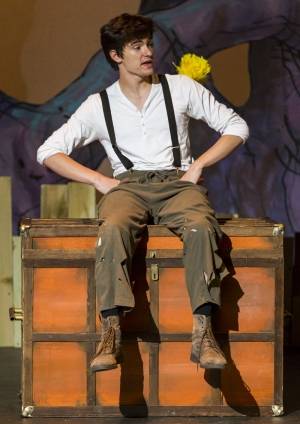

Overall, I enjoyed what each actor brought to their role. Katina Bolos (Molly Aster) and Craig Krukewitt (Lord Leonard Aster) were the stereotypical members of Victorian Britain as the star-catching father and daughter duo. Bolos does a good job of conveying Molly as a curious, know-it-all, thirteen year-old star-catcher apprentice 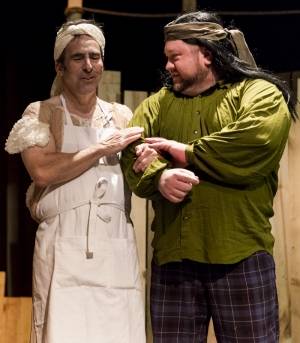 on her first “real” mission. Her nanny Mrs. Bumbrake, played by John Tilford, stands by her side until seaman Alf (Mikel L. Matthews, Jr.) turns his amorous attentions to Mrs. Bumbrake. If anything, the pair could be even more comedic about their odd pairing as lovebirds. Prentiss (Jess Schlipf), a loudmouth orphan, and Ted (Jon Faw), a perpetually hungry orphan, are great compatriots to the sullen and quiet Boy without a name (Isiah Asplund). The Boy without a name and Molly eventually meet on the ship The Never Land. From there, the two actors play as young teenagers eager to impress each other and test the waters of new feelings. However, their feelings and lives are tested by pirates and responsibility (but mostly pirates).
on her first “real” mission. Her nanny Mrs. Bumbrake, played by John Tilford, stands by her side until seaman Alf (Mikel L. Matthews, Jr.) turns his amorous attentions to Mrs. Bumbrake. If anything, the pair could be even more comedic about their odd pairing as lovebirds. Prentiss (Jess Schlipf), a loudmouth orphan, and Ted (Jon Faw), a perpetually hungry orphan, are great compatriots to the sullen and quiet Boy without a name (Isiah Asplund). The Boy without a name and Molly eventually meet on the ship The Never Land. From there, the two actors play as young teenagers eager to impress each other and test the waters of new feelings. However, their feelings and lives are tested by pirates and responsibility (but mostly pirates).
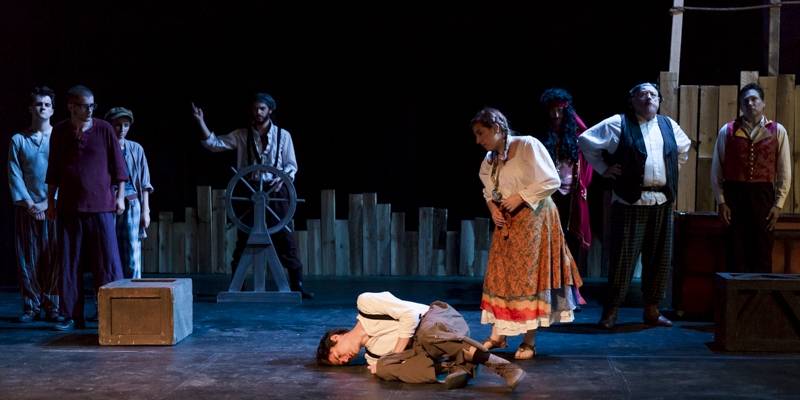
Like with the Disney animated version of Peter Pan, the pirates were always more comical than Pan and his Lost Boys. Grant Morenz (Black Stache) chewed up the scenery and then went back to chew it up again for a laugh. As the charismatic villain of the play, Morenz’s comedic (over) acting brought out the biggest laughs from the audience. His exuberant energy was nicely complemented by Jim Dobbs as the quiet, obviously smarter than Black Stache, and ever-suffering, Smee. The two make a good pair on stage. Another good pair were Jace Jamison as Fighting Prawn and Chris “Fing” Guyotte as his son Hawking Clam. It was a lovely sight gag that I found hilarious.
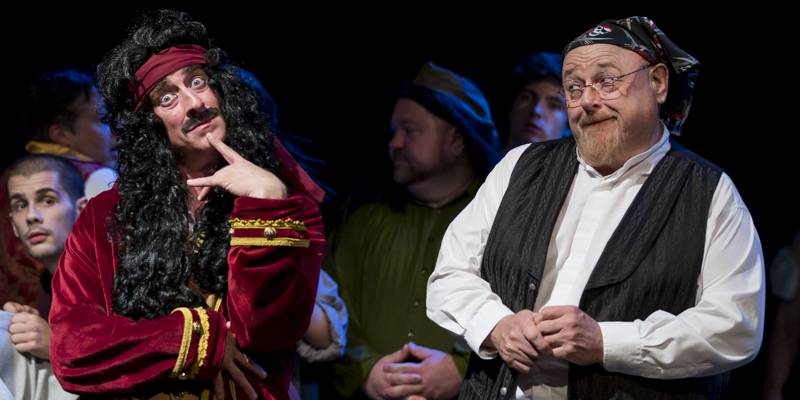
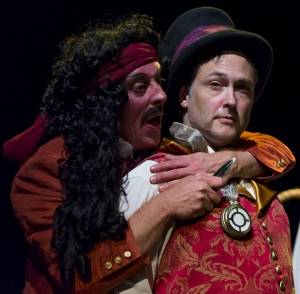 For most of the play, the actors rely on their costumes to convey their shifting roles. One minute Evan Seggebruch is donning a naval military jacket to portray Captain Robert Falcon Scott of The Wasp; the next, he throws on a henley thermal shirt to play a nameless pirate in Black Stache’s crew. Even Lord Aster has an eye patch under his top hat in order to join the pirates’ number. These touches by Thom Schnarre help to visually know when an actor is playing a certain role or not.
For most of the play, the actors rely on their costumes to convey their shifting roles. One minute Evan Seggebruch is donning a naval military jacket to portray Captain Robert Falcon Scott of The Wasp; the next, he throws on a henley thermal shirt to play a nameless pirate in Black Stache’s crew. Even Lord Aster has an eye patch under his top hat in order to join the pirates’ number. These touches by Thom Schnarre help to visually know when an actor is playing a certain role or not.
The stage design by scenic designer Nicholas Schwartz and lighting designer Xuan Li Leong was also well done. Boards lined the wings of the stage to give a sense of a ship’s deck. On house left and right of the stage, the wings are built up into platforms that come in handy for both the actors and the stage crew. The stage design along with the choreography by Monica Samii and music direction by Griffin Jenkins really added to the musical production.
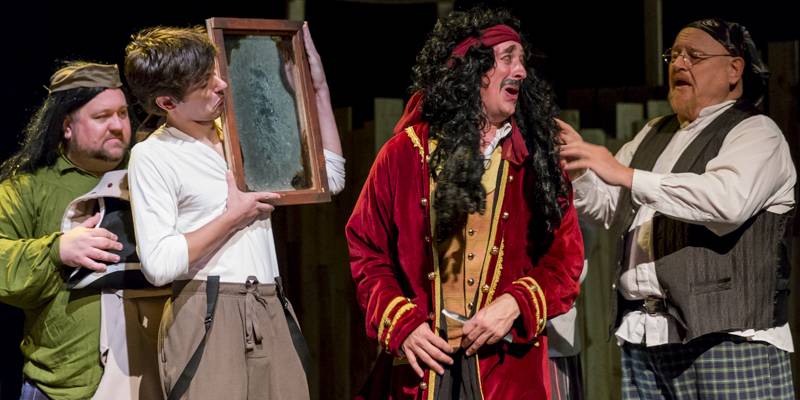
When the play was over, my friend and I had a lengthy conversation about the musical. For both of us, we found the huge amounts of in-character and out-of-character expositions to be disruptive and sometimes confusing. In the first scene, you are told a number of basic fundamentals for the plot: that there are chests (one with star stuff and one without) and ships (The Never Land and The Wasp) and captains (Bill Slank and Captain Scott) and crews and characters being separated and shipped off to Rundoon, a mythical kingdom. Some of the exposition felt like an unnecessary footnote. While humorous at times (like using the names of Italian culinary dishes for a made-up language), there were times when the writing felt awkward for the Victorian albeit fantasy setting. A pirate saying “TTFN!” seemed a little odd more than funny. There was also the strange mix of incredibly highbrow jokes (“Does a Philip Glass composition have a melody?” for example) and juvenile lowbrow jokes (“Your name means ‘squid poop’ in our language.”).
All in all, Peter and the Starcatcher is worth catching if you enjoy dastardly pirates, heroic young girls, prequel stories about familiar characters, and mermaids in attire dissimilar to shell bras and singing about how great it is to be a mermaid and not a fish anymore.
—
Peter and the Starcatcher is now showing at Parkland College’s Harold and Jean Miner Theatre at 7 p.m. until September 18th with Sunday matinee-only performances starting at 2 p.m. Tickets are $15 for adults and $12 for students and seniors. Reserved seating is available online.








